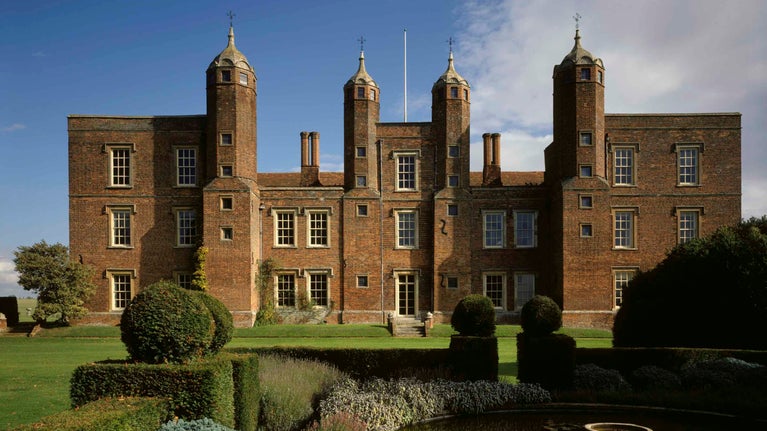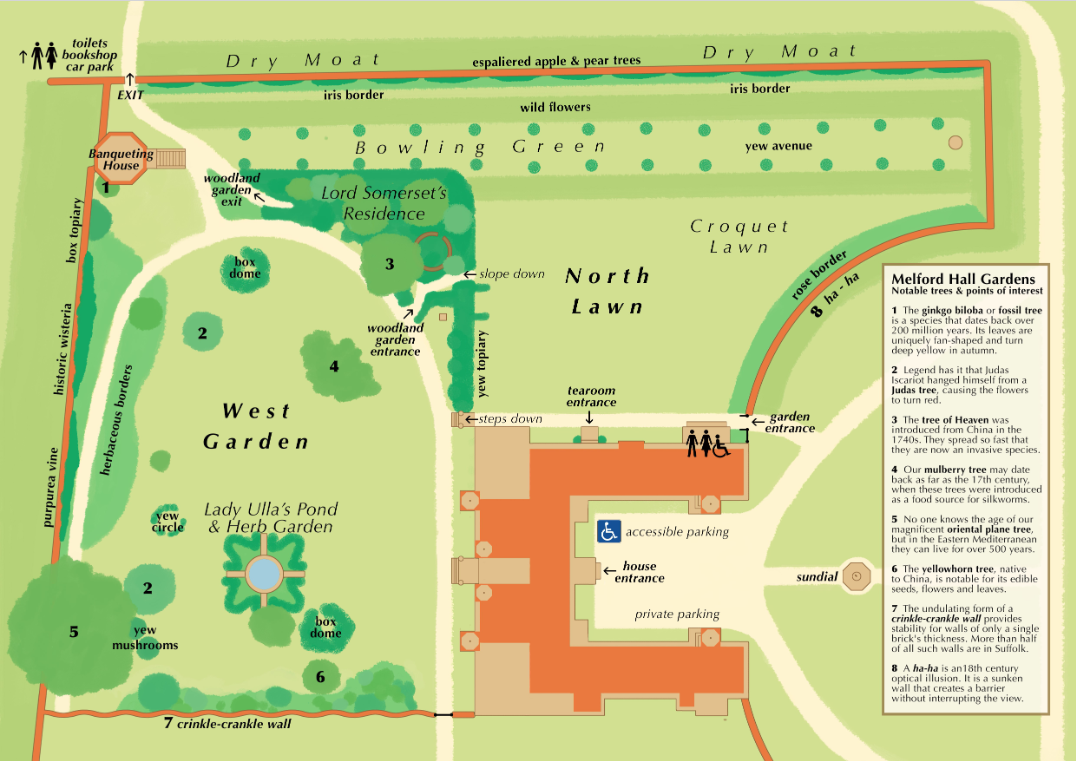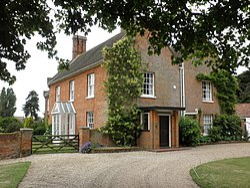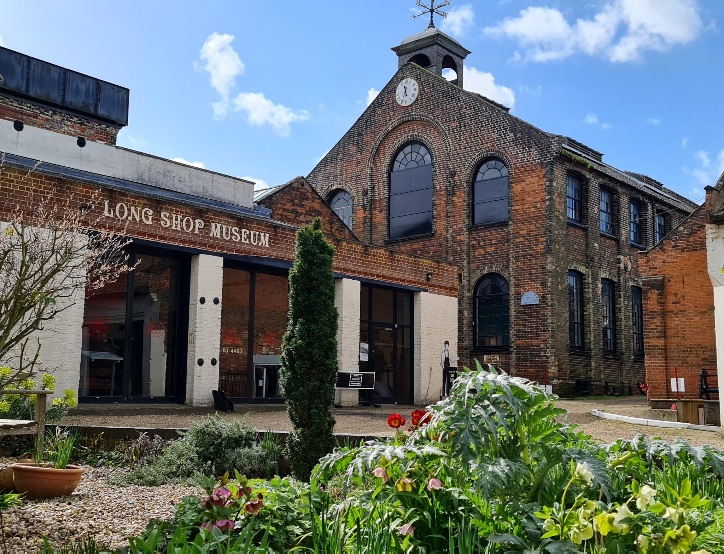Details of the Summer Visits arranged for 2024. See the programme page for booking information.
Melford Hall Gardens
Long Melford,Sudbury, Suffolk, CO10 9AA
Wednesday June 19th 2024 from 11:00 – 1:00.
Meet in the car park by the entrance.
Ticket cost £8.00 for National Trust members (please say when booking) £20.00 for non-National Trust members. Numbers limited to 20
Edward Martin will be giving us a guided tour of the beautiful and historic gardens of Melford Hall. We are very lucky to have been given special permission by Lady Hyde Parker to view the 1613 map of the garden in the private apartments as part of the visit. Once the tour has finished the public areas of the Hall are available to view as either National Trust members or with the ticket for non-members. There is a café on-site.

The West Garden
This part of the garden is dominated by the Banqueting House that was built by Sir Thomas Savage to entertain his most favoured guests. At the other end of the garden, we have the crinkle-crankle wall, originally built in 1739 but rebuilt after the gales of 1987. There are a number of specimen trees to admire, such as the Oriental plane and the Judas trees. In the lawn is Lady Ulla’s Pond, which is being renovated and will be a reflecting pond. It provides a habitat for great crested newts and other amphibians, which we’re carefully managing to ensure that they can thrive. There are herbaceous borders by the west wall, along with a 100-year-old wisteria that will be in full bloom in May.

Lord Somerset’s Residence
In the north-east corner is ‘Lord Somerset’s Residence’, a quiet woodland corner planted with a variety of shade-loving plants. The woodland supports a variety of wildlife and is a favourite spot to look for insects or catch a glimpse of smaller garden birds. Look out for the avenue of yew trees that runs from the banqueting house down to a large, planted urn. Down in the moat, you’ll find espaliered fruit trees and a flower border of irises.
The Parkland
Created by Sir John Savage in 1613, Melford Hall is surrounded by a vast historic deer park. Spanning 130 acres, and sporting a varied selection of specially mown paths, it’s the perfect place to enjoy a breath of fresh country air. As you walk up the hill, enjoy views of the north and east facades of the Hall, which has been standing for close to 500 years. When you reach the took lookout for two local landmarks, which many villagers view as the sign that they’ve arrived home. On your right is the Cedar of Lebanon tree, which stands proud and dominant in the landscape, and, in the distance, you can see the tower of the 15th-century church, which contains one of the finest collections of medieval stained glass in the country.
The House
Melford Hall is a fine example of a turreted Tudor manor house built in the mid-16th century incorporating parts of an earlier manor house. It was built for Sir William Cordell, a successful lawyer, whose flexible approach to public affairs enabled him to serve Henry VIII, Edward VI, Mary Tudor and Elizabeth I, who stayed at Melford in 1578. It was bought by Sir Harry Parker in 1786. The east front of the house boasts a magnificent Renaissance 2-storey porch with Doric and Ionic fluted pilasters. Although Melford has undergone a number of significant changes –it was altered, for instance, from a courtyard to an E-plan – the exterior still retains much of its Elizabethan flavour. In 1813, interior alterations were made by Thomas Hopper for Sir William Parker, including an ornate classical Regency library and Greek revival staircase. A rare octagonal Tudor pavilion built of brick graces the garden.
THE RED HOUSE
GOLF LANE, ALDEBURGH, IP15 1PZ

Wednesday 10th July, 2.30pm
Gather at the location. Numbers limited to 25.
The cost will be £18 per person and will include tea and biscuits during an interval in the visit.
Afterwards members will be able to walk around the magnificent garden and, as an added bonus, their individual ticket of admission will remain valid for a further year permitting them to re-visit the House at any time.
The Red House is well signposted and easy to find. Turn sharp left at the first roundabout on entering Aldeburgh on to Leiston Road and after about half a mile turn left again. There is more than adequate parking at the location, but we will be happy to co-ordinate car sharing for those without their own transport.
The Red House was the home of the composer Benjamin Britten, from 1957 until his death in 1976, and of his partner, Peter Pears, until the latter’s death in 1986. It is now one of two headquarters for Britten Pears Arts, with the other being Snape Maltings Concert Hall.
The Britten-Pears Foundation reinstated Britten’s grand piano to the first-floor studio in the Red House grounds as part of a £4.7 million restoration project in 2013. The Foundation promotes Britten and Pears’ music legacy, and the buildings and grounds at The Red House serve this end, being open to the public and the setting for an archive of Britten’s work, exhibition spaces, and a centre for music research. The Foundation also manages the house and the associated art collection, including sculpture The art collection, comprising some 1,300 works, is superb and predominately that built up by Britten and Pears, although the Foundation has made acquisitions of its own, either of art relating to Britten’s work, or of artists influenced by him.
The visit will be very reminiscent for those members who visited Benton End in Hadleigh: albeit the Red House is much more developed and in many ways represents what the folk at Benton are hoping to achieve – and in much the same way, our party of around twenty participants will be given a guided tour of the house to be followed by a talk by the House Archivist about the activities and purpose of the Foundation.
The Long Shop Museum
Main Street, Leiston, Suffolk IP16 4ES
Tuesday 13th August at 11.00am
Meet at the entrance.
Ticket cost: £6.00 (includes free re-entry for 12 months and ‘help-yourself’ tea/coffee and biscuits).
We will be given a guided tour of this fascinating museum. This visit is of particular interest following the excellent talk given to the Society by Fraser Hale this year.

The Long Shop Museum was founded in 1984.It is housed in a cluster of historic buildings in the Suffolk market town of Leiston. The buildings are survivors of the original 19th century works site of Richard Garrett and Sons.
Garretts were world-famous manufacturers of steam engines and other agricultural machinery, and the Museum has important collections relating to farming machinery, steam traction, tools and commercial and domestic products that were made by the works during its 200-year history – from sickles to steam engines, from seed drills to tumble dryers, and from threshers to box makers.
The Museum site covers over an acre. It includes several historic, and listed buildings. The Long Shop itself – a prototype for assembly line production – is unique and grade II* listed.
Around the Museum, several other works buildings also remain. These have been converted to other uses but retain their character and enhance the Museum experience for visitors.
The museum also holds significant collections relating to the Garret family, including Elizabeth Garrett Anderson, the first woman doctor in England. The museum helps to explain the town’s industrial character and how its residents contributed to the agricultural and industrial revolutions.
